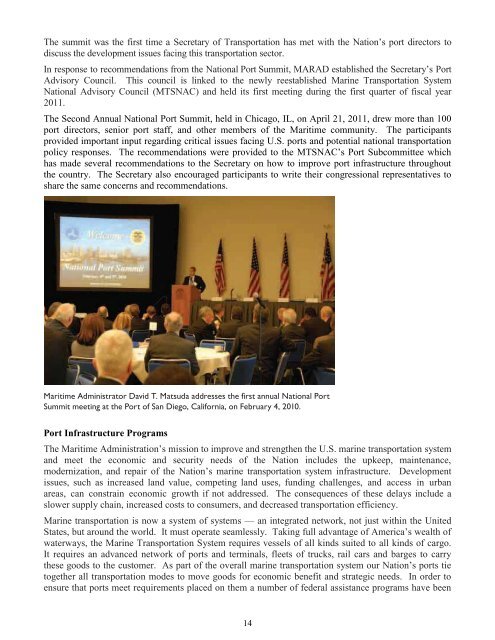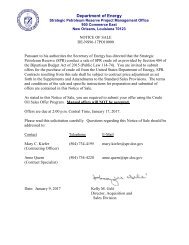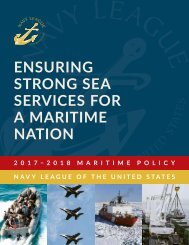2010-11_ANNUAL_REPORTS_-_FINAL_VERSION_(3)
2010-11_ANNUAL_REPORTS_-_FINAL_VERSION_(3)
2010-11_ANNUAL_REPORTS_-_FINAL_VERSION_(3)
You also want an ePaper? Increase the reach of your titles
YUMPU automatically turns print PDFs into web optimized ePapers that Google loves.
The summit was the first time a Secretary of Transportation has met with the Nation’s port directors to<br />
discuss the development issues facing this transportation sector.<br />
In response to recommendations from the National Port Summit, MARAD established the Secretary’s Port<br />
Advisory Council. This council is linked to the newly reestablished Marine Transportation System<br />
National Advisory Council (MTSNAC) and held its first meeting during the first quarter of fiscal year<br />
20<strong>11</strong>.<br />
The Second Annual National Port Summit, held in Chicago, IL, on April 21, 20<strong>11</strong>, drew more than 100<br />
port directors, senior port staff, and other members of the Maritime community. The participants<br />
provided important input regarding critical issues facing U.S. ports and potential national transportation<br />
policy responses. The recommendations were provided to the MTSNAC’s Port Subcommittee which<br />
has made several recommendations to the Secretary on how to improve port infrastructure throughout<br />
the country. The Secretary also encouraged participants to write their congressional representatives to<br />
share the same concerns and recommendations.<br />
Maritime Administrator David T. Matsuda addresses the first annual National Port<br />
Summit meeting at the Port of San Diego, California, on February 4, <strong>2010</strong>.<br />
Port Infrastructure Programs<br />
The Maritime Administration’s mission to improve and strengthen the U.S. marine transportation system<br />
and meet the economic and security needs of the Nation includes the upkeep, maintenance,<br />
modernization, and repair of the Nation’s marine transportation system infrastructure. Development<br />
issues, such as increased land value, competing land uses, funding challenges, and access in urban<br />
areas, can constrain economic growth if not addressed. The consequences of these delays include a<br />
slower supply chain, increased costs to consumers, and decreased transportation efficiency.<br />
Marine transportation is now a system of systems — an integrated network, not just within the United<br />
States, but around the world. It must operate seamlessly. Taking full advantage of America’s wealth of<br />
waterways, the Marine Transportation System requires vessels of all kinds suited to all kinds of cargo.<br />
It requires an advanced network of ports and terminals, fleets of trucks, rail cars and barges to carry<br />
these goods to the customer. As part of the overall marine transportation system our Nation’s ports tie<br />
together all transportation modes to move goods for economic benefit and strategic needs. In order to<br />
ensure that ports meet requirements placed on them a number of federal assistance programs have been<br />
14




